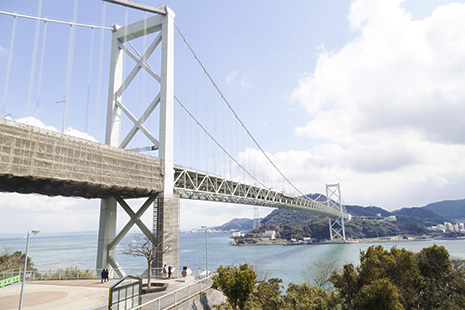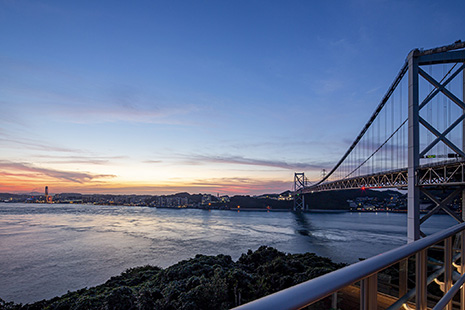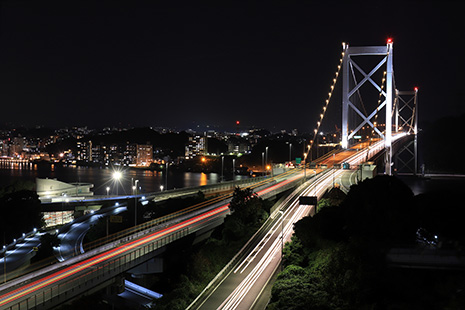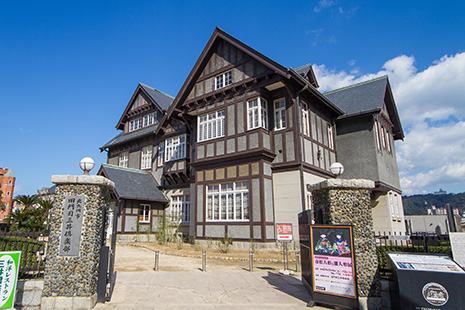March 2024
- English
- 日本語
The Kanmon Bridge — A Key Transportation Link Between Honshu and Kyushu Crossing the Kanmon Strait
-

The Kanmon Bridge seen from the Honshu side of the strait (Shimonoseki City, Yamaguchi Prefecture)
Photo: NEXCO West -

Sunset view from the observation deck of the Mekari Parking Area, the entrance of Mekari Seaside Promenade
Photo: NEXCO West
-

The Kanmon Bridge has a suspension structure that ensures a clear navigational channel for vessels passing through the Kanmon Strait.
Photo: NEXCO West -

View of the illuminated Kanmon Bridge from the Shimonoseki side
Photo: Yamaguchi Prefectural Tourism Federation -

Many historic Western-style buildings, including the Former Moji Mitsui Club built in 1924, are preserved in the Moji Port in Kitakyushu City, Fukuoka Prefecture.
Photo: mojiko retoro

Photo: NEXCO West
The Kanmon Bridge, which connects Japan's main island of Honshu and Kyushu, the large southerly island, is a 1,068-meter-long suspension bridge built using an innovative construction method. It represents a milestone in the history of suspension bridges in Japan.
The Kanmon Strait separates two of Japan's large islands, Honshu and Kyushu. Shimonoseki City of Yamaguchi Prefecture is on the Honshu side of the strait and Kitakyushu City of Fukuoka Prefecture is on the Kyushu side. Since ancient times, this waterway has been an important transport route, and it has seen much overseas trade. The first bridge in history to span the strait, the Kanmon Bridge was built as part of the Kanmon Expressway, looking to solve the problem of increased traffic in the Kanmon Roadway Tunnel passing through the undersea, which opened in 1958. Construction of the bridge began in 1968 and was completed in 1973. Fukamatsu Noriyuki from the Public Relations Department of West Nippon Expressway Company Limited (NEXCO West) tells us about the Kanmon Bridge.

Photo: NEXCO West
"The Kanmon Strait continues to be an important logistical and transport hub with a lot of heavy vessel traffic. Approximately 60,000 vessels of 500 gross tons or more traverse the straight each year, averaging out to about 500 vessels per day.* When deciding on the type of bridge structure,** therefore, the engineers had to consider the need to ensure a smooth navigational channel for ships passing through the strait. Consequently, the Kanmon Bridge was built as a long-span*** suspension bridge. With a height of approximately 61 meters above sea level (at high tide) and a central span (distance between towers) of 712 meters, the bridge was one of the top ten largest in the world at the time it opened."
The two main cables supporting the suspension bridge, one on each side, are approximately 66 cm in diameter, and each cable uses 14,014 galvanized steel wires bundled in parallel to form a parallel wire cable. This project was the first time this construction method was used in Japan.
"Previously, cables were twisted to make them easier to handle on the construction site. Twisting increased the total weight by 10%, which could result in a loss of strength. For this project, however, the engineers adopted a method of using the cables without twisting them. In the new method, called Pre-fabricated Parallel Wire Strand (PPWS), 91 wires were bundled into parallel strands in advance at a factory, wound on reels, and shipped. At the construction site, the strands were unwound from the reels and installed in a single operation. This method was also used in the construction of the Akashi Kaikyo Bridge, and it went on to influence other bridge construction projects."

Photo: Yamaguchi Prefectural Tourism Federation
In addition, the bridge's location across the Kanmon Strait exposes it to constant sea winds. This induces a severely corrosive environment, making maintenance and management challenging. To solve this problem, the engineers took a step rare for that time, applying an anti-corrosion coating to the stiffening girders**** that support the roadway. This was the first attempt at a large-scale application of this highly durable coating method, which has since been employed for a large number of public buildings.
"The knowledge and technology gained from the construction of the Kanmon Bridge were later used in the construction of the Honshu-Shikoku Bridge (See: Seto Ohashi Bridge — The Dream Bridge That Connects Honshu with Shikoku) and other long-span bridges built in the 1980s. It is a truly historic bridge that set an important precedent for the subsequent development of bridge projects in Japan."

Photo: NEXCO West
The Kanmon Bridge cannot be crossed on foot, but it is possible to walk back and forth across the Kanmon Strait through a 780-meter-long undersea tunnel called the Kanmon Pedestrian Tunnel. The Mekari Seaside Promenade on the Kyushu side of the Kanmon Strait in Moji Ward of Kitakyushu City (Fukuoka Prefecture) offers a spectacular close-up view of the Kanmon Bridge. It is also fun to watch the various ships passing by and ponder the history of the ancient battlefield of Dan-no-ura.***** The Kanmon Bridge is especially beautiful in the evening when it is illuminated. The area around Moji Port near the promenade is called Mojiko Retro. Many overseas tourists visit this atmospheric district, which still retains many historical buildings. On the other hand, Shimonoseki City, where the Kanmon Bridge touches the ground on the Honshu side, offers a wide variety of seafood dishes, including the famous fugu (blowfish).

Photo: mojiko retoro
If you have an opportunity, a visit to the Kanmon Bridge and the surrounding areas is highly recommended.
* https://www.pa.qsr.mlit.go.jp/kanmon/11about/index4.html
** Structures erected over rivers, canals, etc., to facilitate traffic
*** The distance between piers (support points)
**** To ensure the stability of the girders in high winds (wind stability), suspension bridges are often reinforced with truss structures, which are created by joining girders into triangles. These structures are called stiffening girders.
***** In 1185, the Heike clan, which had held political power since the mid-12th century, was pursued by the rival forces of the Minamoto clan and, defeated and destroyed in the final decisive battle of Dan-no-ura.

